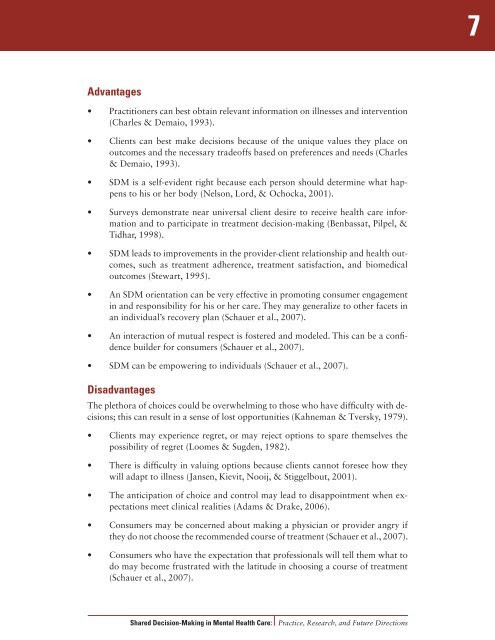Shared Decision-Making in Mental Health Care - SAMHSA Store ...
Shared Decision-Making in Mental Health Care - SAMHSA Store ...
Shared Decision-Making in Mental Health Care - SAMHSA Store ...
You also want an ePaper? Increase the reach of your titles
YUMPU automatically turns print PDFs into web optimized ePapers that Google loves.
7Advantages• Practitioners can best obta<strong>in</strong> relevant <strong>in</strong>formation on illnesses and <strong>in</strong>tervention(Charles & Demaio, 1993).• Clients can best make decisions because of the unique values they place onoutcomes and the necessary tradeoffs based on preferences and needs (Charles& Demaio, 1993).• SDM is a self-evident right because each person should determ<strong>in</strong>e what happensto his or her body (Nelson, Lord, & Ochocka, 2001).• Surveys demonstrate near universal client desire to receive health care <strong>in</strong>formationand to participate <strong>in</strong> treatment decision-mak<strong>in</strong>g (Benbassat, Pilpel, &Tidhar, 1998).• SDM leads to improvements <strong>in</strong> the provider-client relationship and health outcomes,such as treatment adherence, treatment satisfaction, and biomedicaloutcomes (Stewart, 1995).• An SDM orientation can be very effective <strong>in</strong> promot<strong>in</strong>g consumer engagement<strong>in</strong> and responsibility for his or her care. They may generalize to other facets <strong>in</strong>an <strong>in</strong>dividual’s recovery plan (Schauer et al., 2007).• An <strong>in</strong>teraction of mutual respect is fostered and modeled. This can be a confidencebuilder for consumers (Schauer et al., 2007).• SDM can be empower<strong>in</strong>g to <strong>in</strong>dividuals (Schauer et al., 2007).DisadvantagesThe plethora of choices could be overwhelm<strong>in</strong>g to those who have difficulty with decisions;this can result <strong>in</strong> a sense of lost opportunities (Kahneman & Tversky, 1979).• Clients may experience regret, or may reject options to spare themselves thepossibility of regret (Loomes & Sugden, 1982).• There is difficulty <strong>in</strong> valu<strong>in</strong>g options because clients cannot foresee how theywill adapt to illness (Jansen, Kievit, Nooij, & Stiggelbout, 2001).• The anticipation of choice and control may lead to disappo<strong>in</strong>tment when expectationsmeet cl<strong>in</strong>ical realities (Adams & Drake, 2006).• Consumers may be concerned about mak<strong>in</strong>g a physician or provider angry ifthey do not choose the recommended course of treatment (Schauer et al., 2007).• Consumers who have the expectation that professionals will tell them what todo may become frustrated with the latitude <strong>in</strong> choos<strong>in</strong>g a course of treatment(Schauer et al., 2007).<strong>Shared</strong> <strong>Decision</strong>-<strong>Mak<strong>in</strong>g</strong> <strong>in</strong> <strong>Mental</strong> <strong>Health</strong> <strong>Care</strong>:Practice, Research, and Future Directions
















